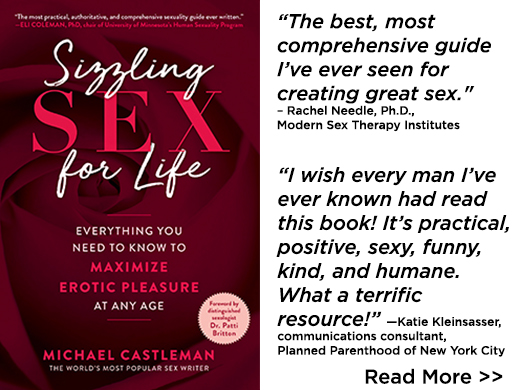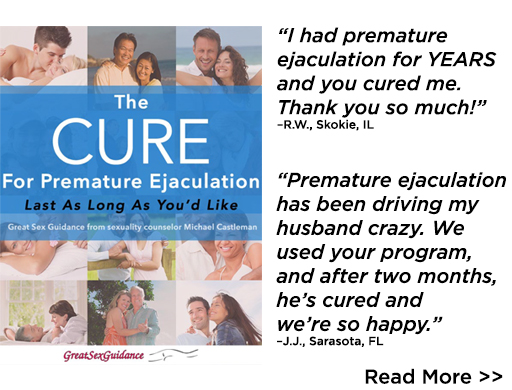
Ever since Pfizer’s erection-boosting drug, Viagra, was approved 1998, the drug companies have been working overtime to develop treatments for women’s sexual issues, notably, low libido. In a few studies, some women reported restored libido and enhanced arousal with Viagra. In several others, however, most experienced no benefit. In 2004, after eight years of efforts to turn Viagra into a drug for women, a disappointed Pfizer, pulled the plug, conceding that women and men are sexually different (surprise!), and that, for reasons that remain unclear, Viagra just doesn’t do much for women.
What Causes Arousal?
Pfizer’s research was based on the conventional notion that desire precedes arousal. You feel sexual desire, and then, if possible, take steps to satisfy it, either by masturbating or partner sex.
Pfizer might have saved a bundle if they’d studied the research on women’s libido by Rosemary Basson, M.D., a clinical professor of psychiatry at the University of British Columbia in Vancouver. She asked hundreds of women to describe how they experience sexual desire and arousal. The results were surprising. Basson discovered that, contrary to the conventional wisdom, for many women, sexual desire is not the cause of lovemaking, but rather, its result. “In a blend of mind and body,” she notes, “arousal often precedes desire.” For these women—and Basson’s research suggests it’s a large group—pills aimed at boosting desire before slipping into bed with a lover is the erotic equivalent of putting the erotic cart before the horse.
Basson’s research has not been widely publicized. But it promises to help many women feel more normal and discover greater fulfillment in lovemaking—if their lovers learn to appreciate leisurely, playful, massage-based, whole-body sensuality.
The Masters and Johnson Sexual Response Cycle
Most of our cultural assumptions about how sex proceeds date from the mid-1960s, when pioneering researchers William Masters, M.D. and Virginia Johnson assumed that sexual desire, that is, libido or sex drive, preceded sexual expression. Given desire, they described a four-stage sexual response cycle in both men and women:
- Arousal. Breathing deepens. Erection or vaginal lubrication.
- Plateau. A high level of arousal in both sexes.
- Orgasm. Pelvic muscle contractions with intense pleasure and release.
- Resolution. Return to a state of non-arousal.
Why Masters And Johnson Got Women Wrong
This four-stage model and the assumption of desire preceding it works well for the vast majority of men—but according to Basson’s research, it’s valid for only a minority of women. When Basson asked women how they respond sexually, many described patterns that bore little resemblance to the four phases described by Masters and Johnson.
Why? Because Masters and Johnson had a bias that distorted their findings—the conviction that men’s and women’s sexual response patterns are virtually identical. At the time of their work, this was a breath of fresh air. It debunked once and for all the lingering Victorian notion that women are incapable of sexual desire and pleasure, that they are merely passive receptacles for men’s lust. Masters and Johnson established beyond scientific doubt that women are as sexually responsive as men.
But they erred when they claimed that women are as sexual as men in the same way men are sexual. It was an honest mistake. Masters and Johnson set out to study sexually normal women. But during the 1960s, “normal” women were presumed to experience orgasm during intercourse. To qualify as Masters and Johnson research subjects, women had to be reliably orgasmic during intercourse.
Orgasmic During Intercourse—Only 25 Percent of Women
How many women are actually reliably orgasmic during vaginal intercourse? Fewer than most people think. For her recent book, The Case of the Female Orgasm, (available from Amazon.com), Indiana University biology professor Elisabeth A. Lloyd, analyzed 32 studies of women’s orgasms, and found that only 25 percent of women consistently have orgasms during intercourse. The rest are all over the map, reporting orgasm during intercourse usually, often, seldom, rarely, or never.
The reason intercourse brings so few women to orgasm is that women’s pleasure organ is not the vagina, but rather the clitoris, which sits outside and above the vagina, under the upper junction of the vaginal lips. For most women, vaginal intercourse—even loving, extended intercourse—does not provide enough direct clitoral stimulation to trigger orgasm. Because Masters’ and Johnson’s female subjects were consistently orgasmic during intercourse (not to mention while using dildos and being observed and filmed in a laboratory), the famed sex researchers based their conclusions about women’s sexuality on a small subset of women and produced an unrealistically narrow view of women’s sexuality.
Does Desire Lead To Sex? Or Does Good Sex Lead To Desire?
Most young men are coiled springs of libido and fairly easily aroused. Men under 40 typically describe their libido as a compelling drive similar to hunger or thirst. Twentieth-century sexologists assumed that women’s experience of libido was, if not identical, then similar—and that if women didn’t feel a drive for sex, there had to be something wrong with them.
Using this reasoning, something would be wrong with about one-third of women. That’s what University of Chicago researchers found in a landmark 1999 survey of more than 3,000 Americans aged 18 to 59. Only 15 percent of the men said they felt little or no desire—and among them, alcohol, emotional stress, and health problems (diabetes, heart disease, disabilities) were clear predictors. But among the women, 30 percent said they lacked libido, and predictors were more elusive. Many reported having little or no sexual desire for no apparent reason. The Chicago researchers concluded that low libido—or in current sexological parlance, “hypoactive desire disorder”—was a disturbingly prevalent problem.
However, the Chicago researchers based this conclusion on the male model of sex, the one that says sexual desire precedes arousal. But according to Basson’s research, for many women, desire does not precede arousal, but rather, results from it. “Women,” Basson explains, “often begin sexual experiences in a state of sexual neutrality.” But as things heat up, so do they. Assuming that these women enjoy the way lovemaking proceeds, by the time they feel highly aroused, they report feeling desire.
The idea that libido is often the product of good sex turns conventional notions of desire upside down. If a substantial proportion of women don’t experience desire before becoming sexual, then drugs and supplements that try to pique it before the fact may be a waste of money.
This new concept of women’s desire neatly explains why Viagra doesn’t work for most women, and why sex-boosting herb blends help only some. These products do not affect desire, per se. Instead, they increase blood flow into the genitals, the physiological basis of sexual arousal. Men are always aware of feeling aroused. It’s hard to miss an erection, and for the vast majority of men, it’s a short step from having an erection to feeling desire. But a good deal of research shows that women are often unaware of genital blood engorgement. “Many women have little awareness of vaginal lubrication,” Basson notes. Even when women are aware it, they often deny feeling interested in sex.
Why Women Have Sex
If so many women don’t experience male-style lust or even mild desire before sex, then why do they make love? According to Basson, often for reasons that affirm their relationships but are not inherently sexual, wanting to please their lover, feel close and intimate, prevent relationship strife, or make up after it. Meanwhile, as lovemaking proceeds and these women become aroused and eventually feel desire, what they desire most may not be orgasm but rather physical closeness with their lover. Basson’s model supports an old saying about the difference between men and women: Men become intimate to have sex. Women have sex to become intimate. Desire in women, for many, is not the cause of sex, but, its result.
Whole-Body Sensuality: An Often-Overlooked Key To Desire
If many women experience desire as the result of lovemaking, then the critical question becomes not how to ignite their desire before sex, but rather: What kind of lovemaking arouses women sufficiently to enable them to experience their libidos? According to leading sexologists, the type of sex that fuels desire is leisurely, playful, sensual lovemaking based on whole-body massage that includes the genitals but is by no means limited to them.
Whole-body massage is a fundamental tool of modern sex therapy. Unfortunately, it’s often missing from sex. One of women’s main complaints about the way men make love is that the male sex style is non-sensual, too rushed, and too focused on the breasts, genitals, and quick, plunge into intercourse. Given Basson’s view of women’s desire, this complaint makes perfect sense. Rushed lovemaking doesn’t give many women the time they need to become aroused enough to experience desire.
Basson’s perspective also explains, in part, why so many women object to pornography. In addition to depicting sex without relationships, porn sex utterly lacks sensuality. It’s all genital all the time. In fact, every square inch of the body is a sensual playground. It’s sad that pornography and so many men explore only a few corners, and often ignore everything else.
Forget “Foreplay,” Embrace “Loveplay”
In conventional sex, lovers engage in foreplay for a while and then proceed to intercourse. The very word, “foreplay,” implies that it happens before the main event, intercourse.
Forget foreplay. Foreplay implies linear lovemaking, first kissing, next some fondling here and there, and finally intercourse, after which sex is over. Instead, lovers—men in particular—should focus on “loveplay,” extended, playful, whole-body massage. “Loveplay” carries no implication that it comes before anything else. It allows more sensual creativity. You might begin by gently holding one another, kissing, and stroking each other’s faces and arms. Next you might undress, shower together, dry each other, and have a glass of wine. After that, you might repair to bed, light candles, turn on some music, kiss, and massage each other’s necks, shoulders, and backs. Then, well, you get the idea. None of this is “foreplay.” It’s all loveplay. “I wish men would learn that sex is best when it involves a slow pace and loving touch that explores the whole body,” says New York sex educator Betty Dodson, Ph.D. “Sure, the genitals are important, but so is everything else. Guys who rush into genital sex are clueless. Give me a lover who knows how to use his fingers, palms, lips, and especially his tongue all over me for a nice long time.”
Now, some men recoil from the idea of whole-body loveplay. They object to “all that touchy-feely stuff.” They’re convinced that “sex” means intercourse and nothing more. They view women’s preference for whole-body sensuality as an annoyance that just postpones “real” sex, intercourse. But the fact is, leisurely, playful, whole-body massage not only enhances women’s experience of lovemaking—but also men’s.
The sexual style that allows women to experience their libidos is the very same style that sex therapists recommend for men who want to cure premature ejaculation and overcome erection difficulties. In other words, a sensual, massage-based approach to lovemaking is a win-win. Men’s penises act the way men want. And women are much more likely to become the aroused, enthusiastic, libidinous lovers that both they and their lovers would like them to be.
For individual help with desire issues, consult a sex therapist. To find a sex therapist near you, visit the American Association of Sex Educators, Counselors, and Therapists, the Society for Sex Therapy and Research, or the American Board of Sexology.
References:
Chaffai, I. et al. “Body-Related Factors Associated with Female Sexual Dysfunction…” presented at the World Congress of Sexology, 2005.
Harris, G. “Pfizer Gives Up Testing Viagra On Women,” New York Times, 2-28-2004
Heiman, JR. “Sexual Dysfunction: Overview of Prevalence, Etiological Factors, and Treatments,” Journal of Sex Research (2002) 39:73.
Laumann, EO. “Sexual Dysfunction in the United States,” Journal of the American Medical Association (1999) 281:537.
Simons, JS and MP Carey. “Prevalence of Sexual Dysfunctions: Results from a Decade of Resarch,” Archives of Sexual Behavior (2001) 30:177.
Wood, JM et al. “Women’s Sexual Desire: A Feminist Critique,” Journal of Sex Research (2006) 43:236.



